Species Composition and Distribution of Jellyfish in a Seasonally Hypoxic Estuary, Hood Canal, Washington
Abstract
1. Introduction
2. Materials and Methods
2.1. Field Methods
2.2. Laboratory Methods
2.3. Statistical Methods
3. Results
3.1. Environmental Properties
3.2. Species Composition
3.3. NMS Ordinations
3.4. Species Diversity
3.5. Vertical Distributions
4. Discussion
4.1. Trophic Roles
4.2. Vertical Distributions
4.3. Abundance and Community Patterns
Supplementary Materials
Author Contributions
Funding
Acknowledgments
Conflicts of Interest
References
- Larson, R.J.; Madin, L.P.; Harbison, G.R. In situ observations of deepwater medusae in the genus Deepstaria, with a description of D. reticulum, sp. nov. J. Mar. Biol. Assoc. UK 1988, 68, 689–699. [Google Scholar] [CrossRef]
- Pitt, K.A.; Duarte, C.M.; Lucas, C.H.; Sutherland, K.R.; Condon, R.H.; Mianzan, H.; Purcell, J.E.; Robinson, K.L.; Uye, S. Jellyfish body plans provide allometric advantages beyond low carbon content. PLoS ONE 2013, 8, e72683. [Google Scholar] [CrossRef] [PubMed]
- Mills, C.E.; Marques, A.C.; Migotto, A.E.; Calder, D.R.; Hand, C. Hydrozoa: Polyps, Hydromedusae, and Siphonophora. In The Light and Smith Manual: Intertidal Invertebrates from Central California to Oregon, 4th ed.; Carlton, J.T., Ed.; University of California Press: Berkeley, CA, USA, 2007; pp. 118–188. ISBN 978-0520239395. [Google Scholar]
- Agassiz, E.C.C.; Agassiz, A. Seaside Studies in Natural History: Marine Animals of Massachusetts Bay, Radiates, 1st ed.; Ticknor and Fields: Boston, MA, USA, 1865; p. 39. [Google Scholar]
- Parsons, T.R.; Lalli, C.M. Jellyfish population explosions: Revisiting a hypothesis of possible causes. La Mer 2002, 40, 111–121. [Google Scholar]
- Greve, W. The 1989 German Bight invasion of Muggiaea atlantica. ICES J. Mar. Sci. 1994, 51, 355–358. [Google Scholar] [CrossRef]
- Uye, S. Human forcing of the copepod–fish–jellyfish triangular trophic relationship. Hydrobiologia 2011, 666, 71–83. [Google Scholar] [CrossRef]
- Ishii, H. The influence of environmental changes upon the coastal plankton ecosystems, with special reference to mass occurrence of jellyfish. Bull. Plankt. Soc. Jpn. 2001, 48, 55–61. [Google Scholar]
- Purcell, J.E.; Breitburg, D.L.; Decker, M.B.; Graham, W.M.; Youngbluth, M.J.; Raskoff, K.A. Pelagic Cnidarians and Ctenophores in low dissolved oxygen environments: A review. In Coastal Hypoxia: Consequences for Living Resources and Ecosystems; American Geophysical Union: Washington, DC, USA, 2001; pp. 77–100. [Google Scholar]
- Thuesen, E.V. Intragel oxygen promotes hypoxia tolerance of scyphomedusae. J. Exp. Biol. 2005, 208, 2475–2482. [Google Scholar] [CrossRef]
- Rutherford, L.; Thuesen, E. Metabolic performance and survival of medusae in estuarine hypoxia. Mar. Ecol. Prog. Ser. 2005, 294, 189–200. [Google Scholar] [CrossRef]
- Ishii, H.; Ohba, T.; Kobayashi, T. Effects of low dissolved oxygen on planula settlement, polyp growth and asexual reproduction of Aurelia aurita. Plankt. Benthos Res. 2008, 3, 107–113. [Google Scholar] [CrossRef]
- Breitburg, D.L. Behavioral response of fish larvae to low dissolved oxygen concentrations in a stratified water column. Mar. Biol. 1994, 120, 615–625. [Google Scholar] [CrossRef]
- Breitburg, D.L.; Loher, T.; Pacey, C.A.; Gerstein, A. Varying effects of low dissolved oxygen on trophic interactions in an estuarine food web. Ecol. Monogr. 1997, 67, 489–507. [Google Scholar] [CrossRef]
- Purcell, J.E. Predation on zooplankton by large jellyfish, Aurelia labiata, Cyanea capillata and Aequorea aequorea, in Prince William Sound, Alaska. Mar. Ecol. Prog. Ser. 2003, 246, 137–152. [Google Scholar] [CrossRef]
- Purcell, J.E.; Arai, M.N. Interactions of pelagic cnidarians and ctenophores with fish: A review. Hydrobiologia 2001, 451, 27–44. [Google Scholar] [CrossRef]
- Boero, F.; Bouillon, J.; Gravili, C.; Miglietta, M.; Parsons, T.; Piraino, S. Gelatinous plankton: Irregularities rule the world (sometimes). Mar. Ecol. Prog. Ser. 2008, 356, 299–310. [Google Scholar] [CrossRef]
- Orejas, C.; Rossi, S.; Peralba, À.; García, E.; Gili, J.M.; Lippert, H. Feeding ecology and trophic impact of the hydroid Obelia dichotoma in the Kongsfjorden (Spitsbergen, Arctic). Polar Biol. 2013, 36, 61–72. [Google Scholar] [CrossRef]
- Pitt, K.A.; Welsh, D.T.; Condon, R.H. Influence of jellyfish blooms on carbon, nitrogen and phosphorus cycling and plankton production. Hydrobiologia 2009, 616, 133–149. [Google Scholar] [CrossRef]
- Porter, S.C.; Swanson, T.W. Radiocarbon age constraints on rates of advance and retreat of the Puget Lobe of the Cordilleran Ice Sheet during the last glaciation. Quat. Res. 1998, 50, 205–213. [Google Scholar] [CrossRef]
- Gregg, M.C.; Pratt, L.J. Flow and hydraulics near the sill of Hood Canal, a strongly sheared, continuously stratified fjord. J. Phys. Oceanogr. 2010, 40, 1087–1105. [Google Scholar] [CrossRef]
- Newton, J.; Bassin, C.; Devol, A.; Kawase, M.; Ruef, W.; Warner, M.; Hannafious, D.; Rose, R. Hypoxia in Hood Canal: An overview of status and contributing factors. In Proceedings of the 2007 Georgia Basin Puget Sound Research Conference, Seattle, WA, USA, 26–29 March 2007. [Google Scholar]
- Cannon, G.A. Observations of bottom-water flushing in a fjord-like estuary. Estuar. Coast. Mar. Sci. 1975, 3, 95–102. [Google Scholar] [CrossRef]
- Omori, M.; Ikeda, T. Methods in Marine Zooplankton Ecology; John Wiley: New York, NY, USA, 1984; ISBN 0-471-80107-0. [Google Scholar]
- Carpenter, J.H. The accuracy of the Winkler Method for dissolved oxygen analysis. Limnol. Oceanogr. 1965, 10, 135–140. [Google Scholar] [CrossRef]
- Carpenter, J.H. The Chesapeake Bay Institute technique for the Winkler dissolved oxygen method. Limnol. Oceanogr. 1965, 10, 141–143. [Google Scholar] [CrossRef]
- Purcell, J.E. Feeding and growth of the siphonophore Muggiaea atlantica (Cunningham 1893). J. Exp. Mar. Bio. Ecol. 1982, 62, 39–54. [Google Scholar] [CrossRef]
- Shannon, C.E. A mathematical theory of communication. Bell Syst. Tech. J. 1948, 27, 379–423. [Google Scholar] [CrossRef]
- Simpson, E.H. Measurement of diversity. Nature 1949, 163, 688. [Google Scholar] [CrossRef]
- McCune, B.; Mefford, M.J. PC-ORD. Multivariate Analysis of Ecological Data; Version 7.0 for Windows; Wild Blueberry Media: Corvallis, OR, USA, 2016. [Google Scholar]
- McCune, B.; Grace, J.B. Analysis of Ecological Communities; MJM Software Design: Gleneden Beach, OR, USA, 2002; ISBN 0-9721290-0-6. [Google Scholar]
- Mather, P.M. Computational Methods of Multivariate Analysis in Physical Geography; John Wiley & Sons: London, UK, 1976. [Google Scholar]
- Kruskal, J.B. Multidimensional scaling by optimizing goodness of fit to a nonmetric hypothesis. Psychometrika 1964, 29, 1–27. [Google Scholar] [CrossRef]
- Anderson, M.J. A new method for non-parametric multivariate analysis of variance. Austral Ecol. 2001, 26, 32–46. [Google Scholar]
- Mills, C.E. A new hydrozoan, Geomackiea zephyrolata gen. nov., sp. nov. (Anthomedusae: Pandeidae), from inland marine waters of British Columbia and Washington State. Can. J. Zool. 1985, 63, 2172–2175. [Google Scholar] [CrossRef]
- Keister, J.E. Unpublished work. 2020.
- Towanda, T.; Thuesen, E. Ectosymbiotic behavior of Cancer gracilis and its trophic relationships with its host Phacellophora camtschatica and the parasitoid Hyperia medusarum. Mar. Ecol. Prog. Ser. 2006, 315, 221–236. [Google Scholar] [CrossRef]
- Blackett, M.; Licandro, P.; Coombs, S.H.; Lucas, C.H. Long-term variability of the siphonophores Muggiaea atlantica and M. kochi in the Western English Channel. Prog. Oceanogr. 2014, 128, 1–14. [Google Scholar] [CrossRef]
- Purcell, J.E. Dietary composition and diel feeding patterns of epipelagic siphonophores. Mar. Biol. 1981, 65, 83–90. [Google Scholar] [CrossRef]
- Keister, J.E.; Winans, A.K.; Herrmann, B. Zooplankton community response to seasonal hypoxia: A test of three hypotheses. Diversity 2020, 12, 21. [Google Scholar] [CrossRef]
- Purcell, J.E. Predation on fish larvae and eggs by the hydromedusa Aequorea victoria at a herring spawning ground in British Columbia. Can. J. Fish. Aquat. Sci. 1989, 46, 1415–1427. [Google Scholar] [CrossRef]
- Shoji, J.; Masuda, R.; Yamashita, Y.; Tanaka, M. Effect of low dissolved oxygen concentrations on behavior and predation rates on red sea bream Pagrus major larvae by the jellyfish Aurelia aurita and by juvenile spanish mackerel Scomberomorus niphonius. Mar. Biol. 2005, 147, 863–868. [Google Scholar] [CrossRef]
- Mapstone, G.M. Siphonophore (Cnidaria: Hydrozoa) from Canadian Pacific Waters; NRC Research Press: Ottawa, ON, Canada, 2009; ISBN 90-73239-68-0. [Google Scholar]
- Purcell, J.E. Predation by Aequorea victoria on other species of potentially competing pelagic hydrozoans. Mar. Ecol. Prog. Ser. 1991, 72, 255–260. [Google Scholar]
- Purcell, J.E. A review of cnidarians and ctenophores feeding on competitors in the plankton. Hydrobiologia 1991, 216, 335–342. [Google Scholar] [CrossRef]
- Keister, J.E.; Houde, E.D.; Breitburg, D.L. Effects of bottom-layer hypoxia on abundances and depth distributions of organisms in Patuxent River, Chesapeake Bay. Mar. Ecol. Prog. Ser. 2000, 205, 43–59. [Google Scholar] [CrossRef]
- Decker, M.B.; Cieciel, K.; Zavolokin, A.; Lauth, R.; Brodeur, R.D.; Coyle, K.O. Population fluctuations of jellyfish in the Bering Sea and their ecological role in this productive shelf ecosystem. In Jellyfish Blooms; Pitt, K.A., Lucas, C.H., Eds.; Springer: Dordrecht, The Netherlands, 2014; pp. 153–183. ISBN 978-94-007-7014-0. [Google Scholar]
- Haraldsson, M.; Båmstedt, U.; Tiselius, P.; Titelman, J.; Aksnes, D.L. Evidence of diel vertical migration in Mnemiopsis leidyi. PLoS ONE 2014, 9, e86595. [Google Scholar] [CrossRef][Green Version]
- Nogueira, M., Jr.; Brandini, F.P.; Codina, J.C.U. Diel vertical dynamics of gelatinous zooplankton (Cnidaria, Ctenophora and Thaliacea) in a subtropical stratified ecosystem (South Brazilian Bight). PLoS ONE 2015, 10, e0144161. [Google Scholar] [CrossRef]
- Decker, M.B.; Breitburg, D.L.; Marcus, N.H. Geographical differences in behavioral responses to hypoxia: Local adaptation to an anthropogenic stressor? Ecol. Appl. 2003, 13, 1104–1109. [Google Scholar] [CrossRef]
- Brandenberger, J.M.; Louchouarn, P.; Crecelius, E.A. Natural and post-urbanization signatures of hypoxia in two basins of Puget Sound: Historical reconstruction of redox sensitive metals and organic matter inputs. Aquat. Geochem. 2011, 17, 645–670. [Google Scholar] [CrossRef]
- Keister, J.E.; Tuttle, L.B. Effects of bottom-layer hypoxia on spatial distributions and community structure of mesozooplankton in a sub-estuary of Puget Sound, Washington, U.S.A. Limnol. Oceanogr. 2013, 58, 667–680. [Google Scholar] [CrossRef]
- Decker, M.B.; Breitburg, D.; Purcell, J. Effects of low dissolved oxygen on zooplankton predation by the ctenophore Mnemiopsis leidyi. Mar. Ecol. Prog. Ser. 2004, 280, 163–172. [Google Scholar] [CrossRef]
- Moriarty, P.; Andrews, K.; Harvey, C.; Kawase, M. Vertical and horizontal movement patterns of scyphozoan jellyfish in a fjord-like estuary. Mar. Ecol. Prog. Ser. 2012, 455, 1–12. [Google Scholar] [CrossRef]
- Rice, C.A.; Duda, J.J.; Greene, C.M.; Karr, J.R. Geographic patterns of fishes and jellyfish in Puget Sound surface waters. Mar. Coast. Fish. 2012, 4, 117–128. [Google Scholar] [CrossRef]
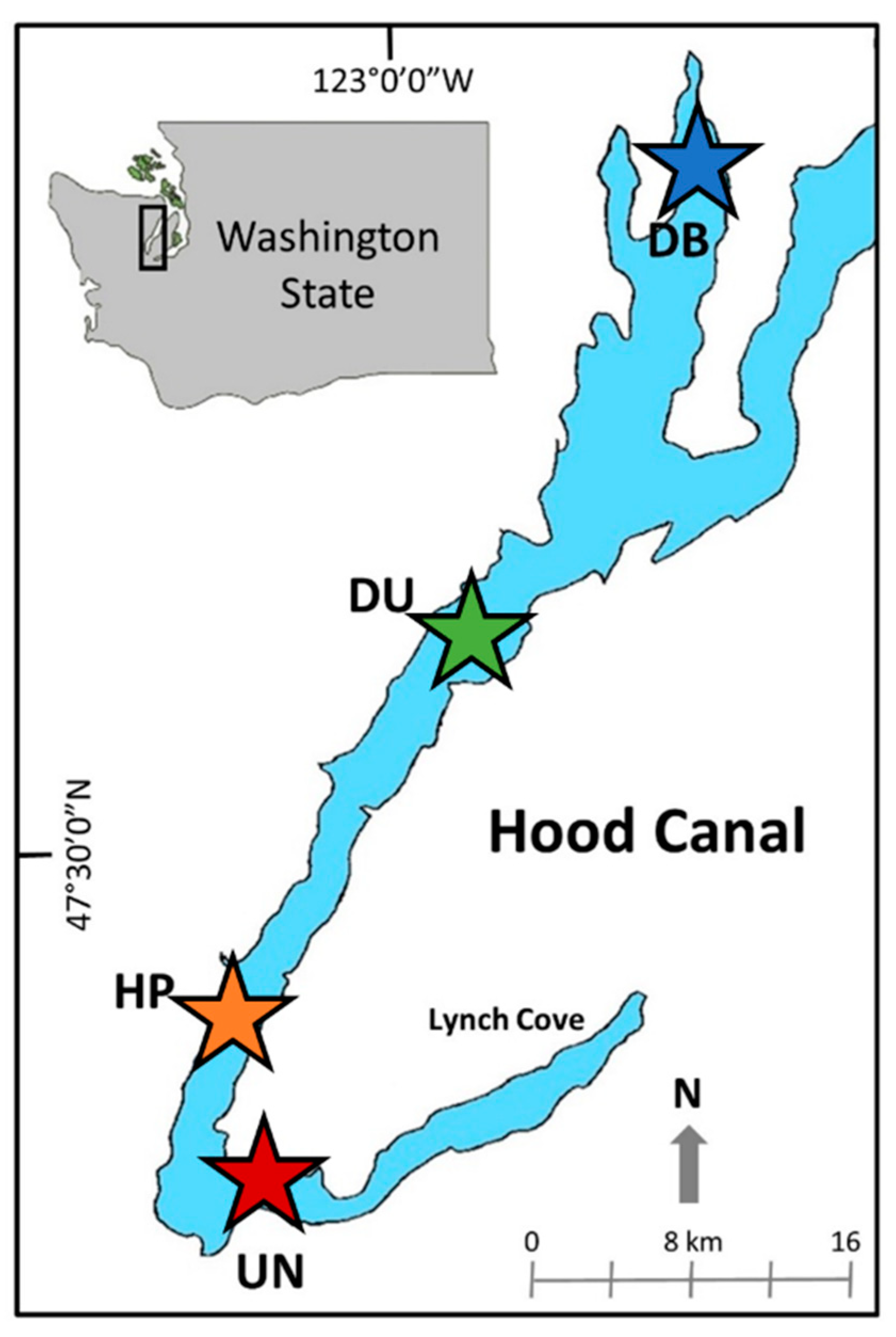
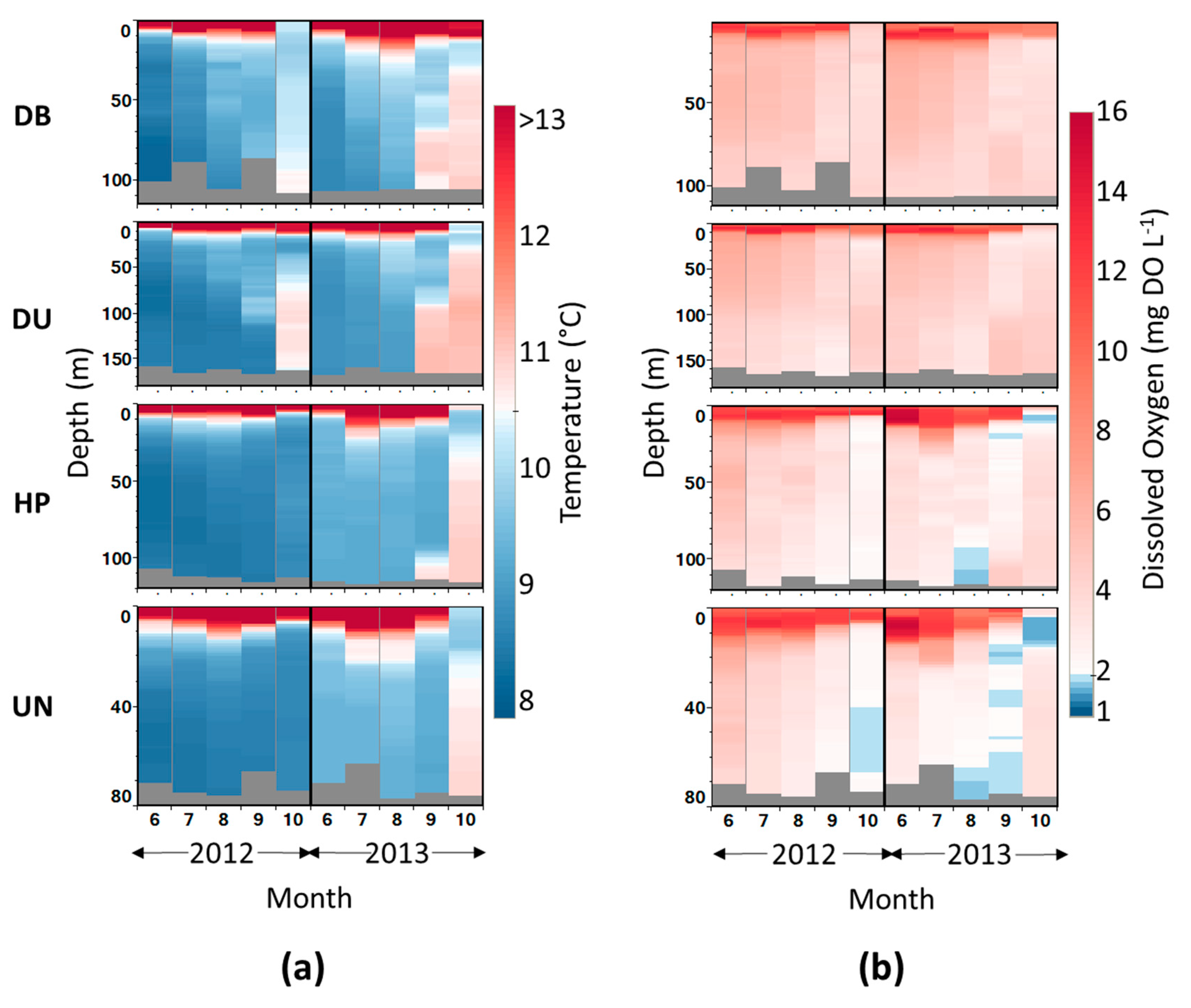

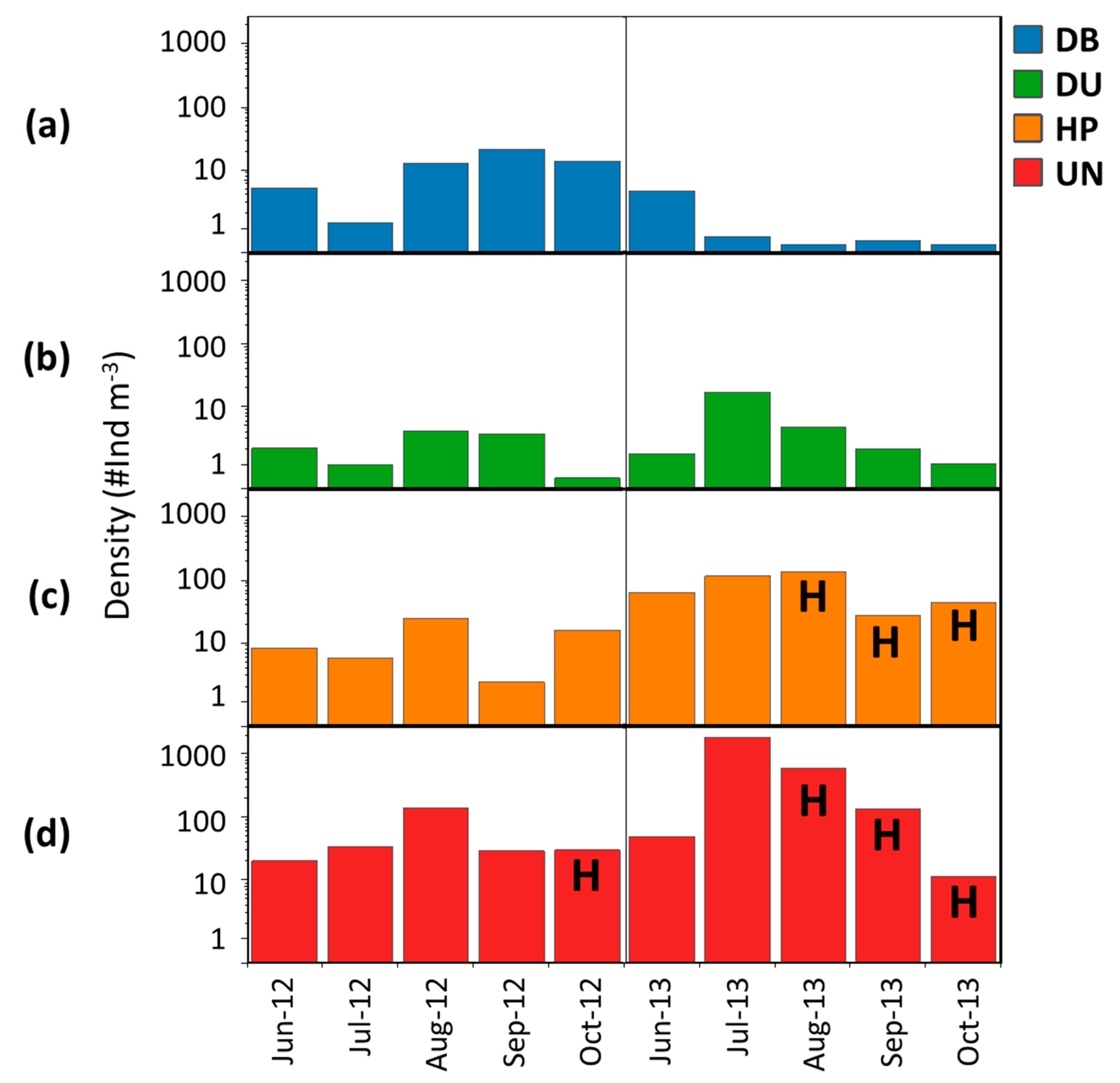
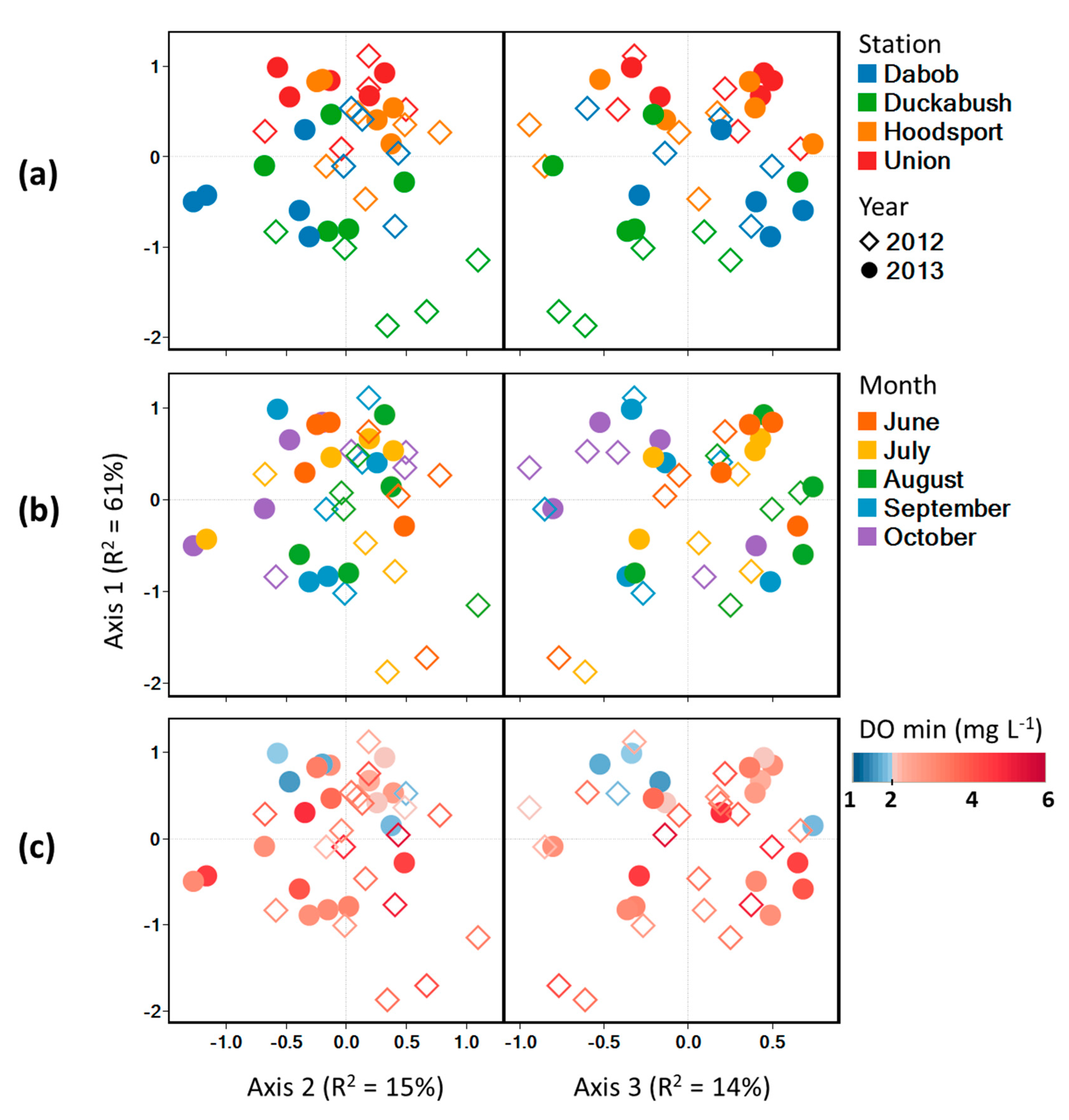

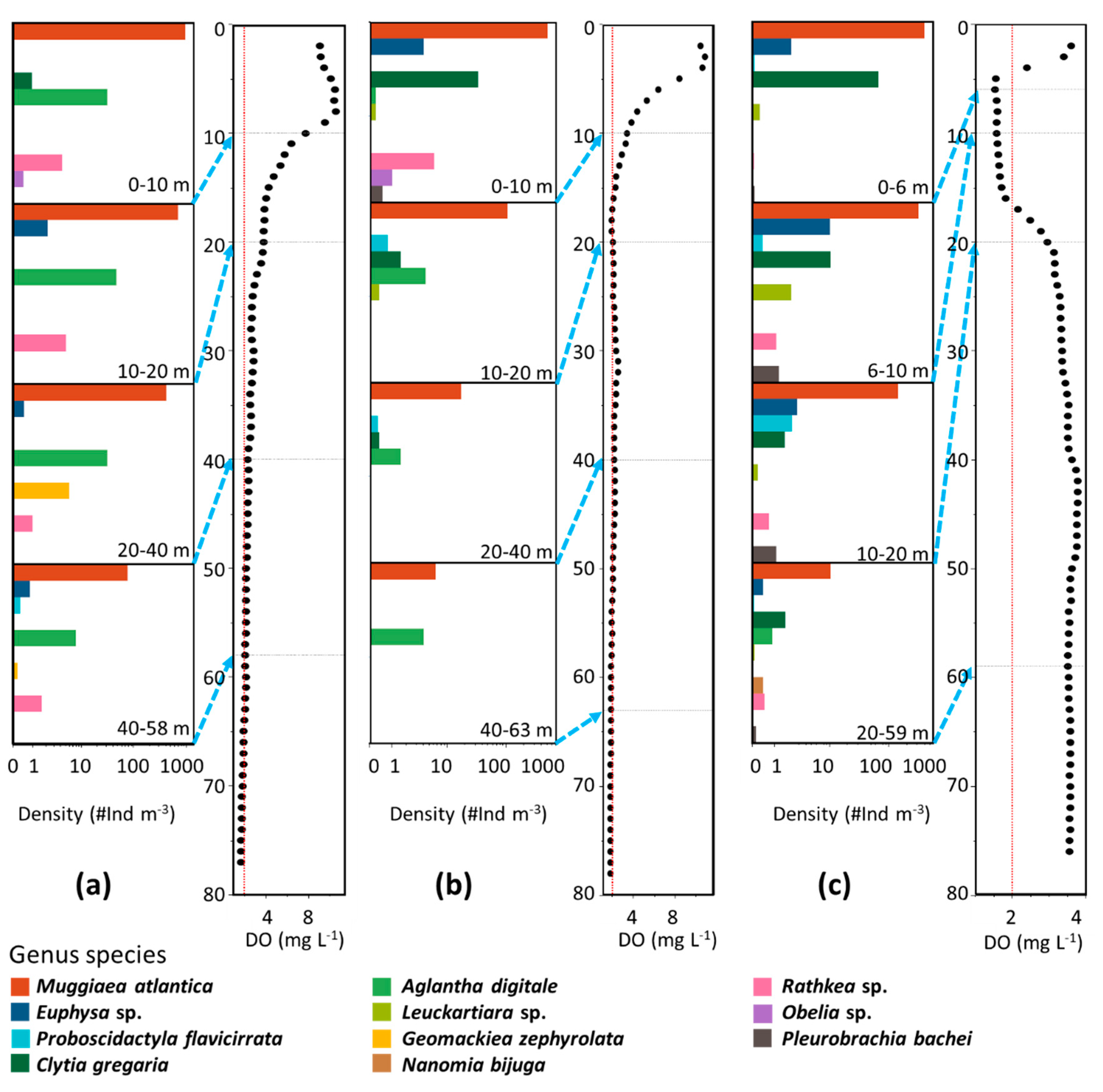
| Class/Order Genus species | Life History Stage | n | Avg D (mm) | Avg H (mm) | Predation Method |
|---|---|---|---|---|---|
| Scyphozoa | |||||
| Aurelia aurita | Medusa | - | - | - | Cruising ★ |
| Cyanea capillata | Medusa | - | - | - | Cruising ★ |
| Phacellophora camtschatica | Medusa | - | - | - | Cruising ★ |
| Hydrozoa | |||||
| Aequorea victoria | Medusa | 19 | 36.63 | 7.68 | Cruising ★ |
| Aglantha digitale | Medusa | 1080 | 2.81 | 4.36 | Ambush ★★ |
| Clytia gregaria | Medusa | 358 | 4.92 | 1.82 | Cruising ★★ |
| Euphysa sp. | Medusa | 146 | 0.79 | 1 | - |
| Geomackiea zephyrolata | Medusa | 25 | 1.5 | 1.49 | - |
| Leuckartiara sp. | Medusa | 117 | 2.26 | 2.76 | Ambush ★★ |
| Obelia sp. | Medusa | 40 | 0.72 | 0.32 | - |
| Proboscidactyla flavicirrata | Medusa | 227 | 3.36 | 2.23 | - |
| Rathkea sp. | Medusa | 79 | 0.72 | 0.59 | - |
| Siphonophora | |||||
| Muggiaea atlantica | Nectophore | 984 | 2.06 | 5.42 | Ambush ★★ |
| Bract | 891 | 0.99 | 1.33 | ||
| Eudoxid | 541 | 0.89 | 2.22 | ||
| Gonophore | 1738 | 0.96 | 1.65 | ||
| Nanomia bijuga | Nectophore | 75 | 2.85 | 3.15 | Ambush ★★ |
| Ctenophora | |||||
| Pleurobrachia bachei | Adult | 95 | 3.88 | 4.16 | Ambush ★★ |
| CUM R2 = 0.89 | Axis 1 (R2 = 0.61) | Axis 2 (R2 = 0.15) | Axis 3 (R2 = 0.14) | |||||
|---|---|---|---|---|---|---|---|---|
| r | R2 | r | R2 | r | R2 | |||
| Aequorea victoria | 0.3 | 0.09 | 0 | 0 | 0.27 | 0.08 | ||
| Aglantha digitale | 0.41 | 0.17 | 0.59 | 0.35 | 0.08 | 0.01 | ||
| Clytia gregaria | 0.81 | 0.65 | 0.12 | 0.01 | −0.3 | 0.09 | ||
| Cyanea capillata | −0.16 | 0.03 | 0.37 | 0.14 | −0.18 | 0.03 | ||
| Euphysa sp. | 0.39 | 0.16 | −0.23 | 0.05 | −0.47 | 0.22 | ||
| Geomackiea zephyrolata | 0.29 | 0.09 | 0.06 | 0 | −0.06 | 0 | ||
| Leuckartiara sp. | 0.52 | 0.27 | −0.1 | 0.01 | 0.62 | 0.38 | ||
| Muggiaea atlantica | 0.87 | 0.75 | −0.06 | 0 | 0.25 | 0.06 | ||
| Nanomia bijuga | 0.01 | 0 | 0.43 | 0.18 | 0.35 | 0.12 | ||
| Obelia sp. | 0.22 | 0.05 | 0.24 | 0.06 | −0.37 | 0.14 | ||
| Pleurobrachia bachei | 0.36 | 0.13 | −0.56 | 0.32 | −0.03 | 0 | ||
| Proboscidactyla flavicirrata | 0.67 | 0.44 | 0.22 | 0.05 | 0.46 | 0.22 | ||
| Rathkea sp. | 0.24 | 0.06 | 0.06 | 0 | −0.11 | 0.01 | ||
© 2020 by the authors. Licensee MDPI, Basel, Switzerland. This article is an open access article distributed under the terms and conditions of the Creative Commons Attribution (CC BY) license (http://creativecommons.org/licenses/by/4.0/).
Share and Cite
Herrmann, B.; Keister, J.E. Species Composition and Distribution of Jellyfish in a Seasonally Hypoxic Estuary, Hood Canal, Washington. Diversity 2020, 12, 53. https://doi.org/10.3390/d12020053
Herrmann B, Keister JE. Species Composition and Distribution of Jellyfish in a Seasonally Hypoxic Estuary, Hood Canal, Washington. Diversity. 2020; 12(2):53. https://doi.org/10.3390/d12020053
Chicago/Turabian StyleHerrmann, BethElLee, and Julie E. Keister. 2020. "Species Composition and Distribution of Jellyfish in a Seasonally Hypoxic Estuary, Hood Canal, Washington" Diversity 12, no. 2: 53. https://doi.org/10.3390/d12020053
APA StyleHerrmann, B., & Keister, J. E. (2020). Species Composition and Distribution of Jellyfish in a Seasonally Hypoxic Estuary, Hood Canal, Washington. Diversity, 12(2), 53. https://doi.org/10.3390/d12020053




